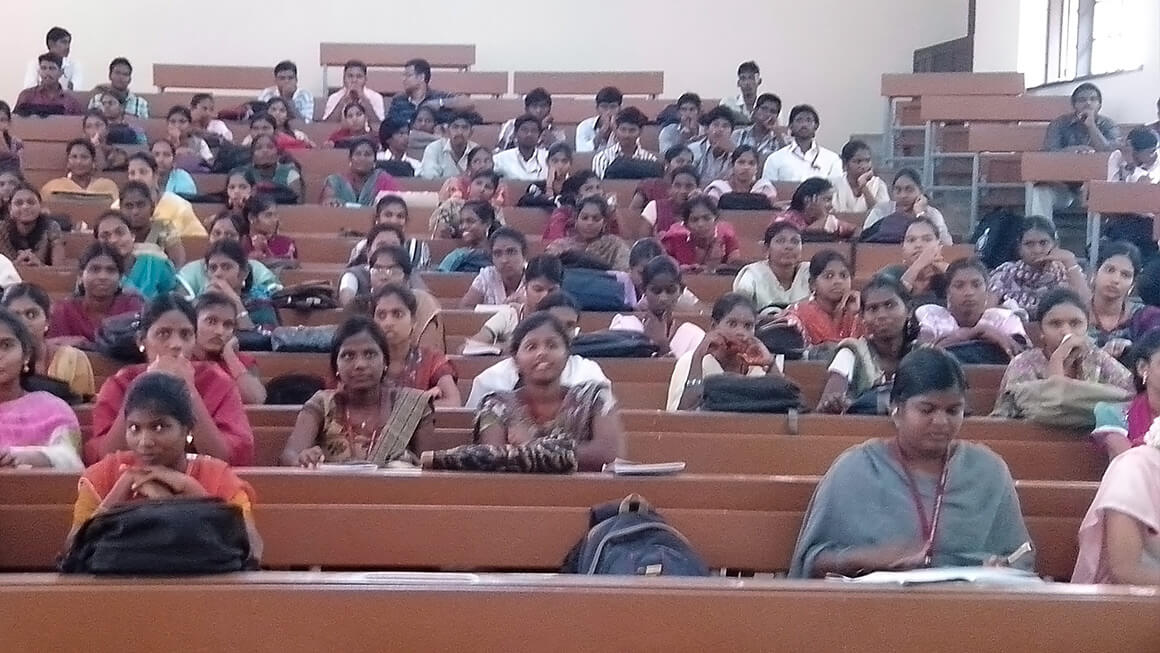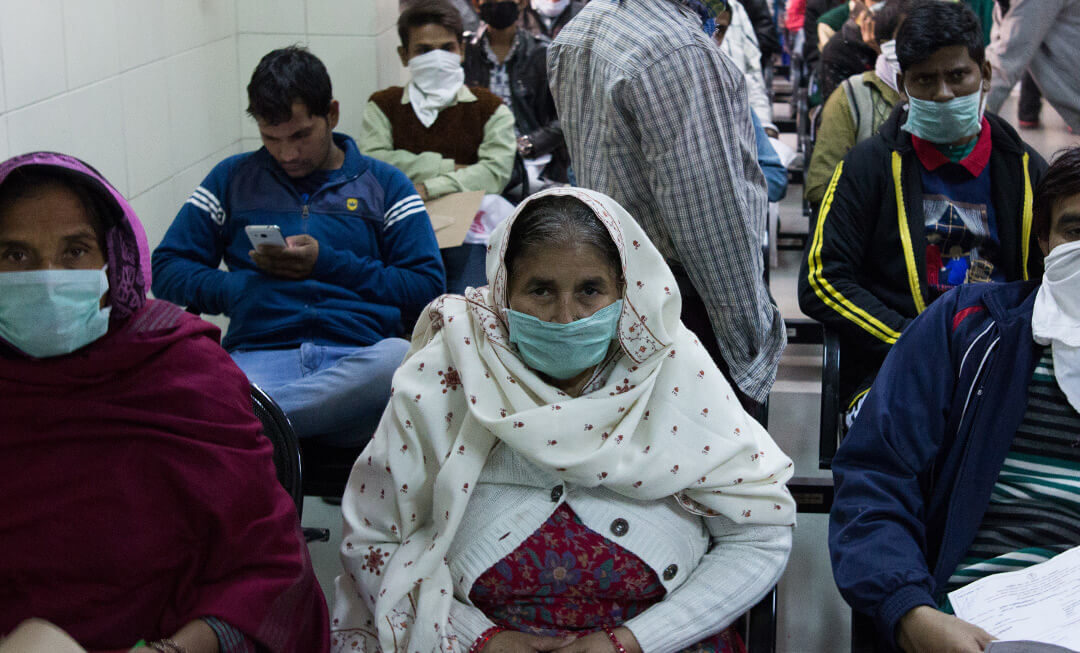(The following article was published in December 2020 on the rupeindia blog. As it retains its relevance and is complementary to the piece in this issue by Manali Chakrabarti and Rahul Varman, it is being re-published here in a slightly edited form. References to the original context have been retained. – Editor.)
Even as we learn the terminology of COVID 19 and its associated phenomena, we are also being educated in a new jargon regarding one of the world’s oldest occupations, namely, teaching. We are now being educated in terms such as ‘online learning’, ‘e-teaching’, ‘edtech’, ‘edutech’, ‘smartphones in the new role of teacher’, and so on and so forth.
India is a large country with a very young population. Almost all households (at least in the urban areas) have some kind of experience in relation to education. But in recent months, ‘online classes’ have become a ‘new normal’, from the most elementary level, such as teaching nursery rhymes, to the most advanced levels – the courses offered to graduate or medical students. Some think that, though the pandemic forced it upon us, this development opens up new possibilities and realms for education; others consider this a temporary phase, after which things would go back to ‘normal’.
How should we view this moment of rampant online teaching? Here we first examine the vision its proponents offer, then critically examine it against our basic conception of education. Finally, we consider the possible consequences of this online turn to teaching for anybody associated with education.
The promise of online teaching
The promise of onlinisation of teaching is epitomised in the words of Sebastian Thrun, one of the early investors in the online education pioneer Udacity. Thrun gushed, “Imagine you can hand a kid in Africa a tablet and give him Harvard on a piece of glass!” Education, especially higher education, is generally associated with elitism in the name of merit, but also with high fees that make it out of reach for sections of the populace who need it the most. As the above quote suggests, online education promises to reach the best quality education to the most needy at a very low price.
Indeed, there has been a spate of reports in India on the reach and opportunity that online technology offers for the business of education and teaching. Among such reports amidst the pandemic and lockdown, the report this year by RedSeer-Omidyar Network is perhaps the most detailed. Very much in line with Thrun’s excitement, this report concludes:
Digital offerings are leading the democratization of education, bridging gaps in access to quality education and addressing key student pain points.
Eight years ago, the New York Times (NYT) declared 2012 the Year of the MOOC. A few months later, NYT columnist Thomas Friedman wrote ecstatically about the “budding revolution in global online higher education”, pronouncing that “Nothing has more potential to lift more people out of poverty”. He further emphasised its “potential to unlock a billion more brains to solve the world’s biggest problems”, as “For relatively little money, the US could rent space in an Egyptian village, install two dozen computers and high-speed satellite Internet access, hire a local teacher as a facilitator, and invite in any Egyptian who wanted to take online courses with the best professors in the world, subtitled in Arabic.” Here is Friedman’s vision in his own words: “I can see a day soon where you’ll create your own college degree by taking the best online courses from the best professors from around the world — some computing from Stanford, some entrepreneurship from Wharton, some ethics from Brandeis, some literature from Edinburgh — paying only the nominal fee for the certificates of completion.”
From the ‘production’ side, critics have pointed out that education is one of the professions where salaries and/or prices (college fees) have increased without concomitant rise in productivity of teachers. One of the basic tenets of neoclassical economics is that wages are supposedly a reflection of labour productivity, and hence a rise in wages should be related to the concurrent rise in output. Noted economist William Baumol and his associate William Bowen talked about the ‘cost disease’ in the 1960s in the performing arts, and other economists have argued this is true of services at large. Perhaps at the top of the list are rising college fees. As economist Richard Vedder provocatively asserted, “teaching is the only profession, with the possible exception of prostitution, where there has been no productivity advance in the 2,400 years since Socrates taught the youth of Athens.” Presumably, online teaching offers the hope of increasing the productivity of teachers and linking professors’ salaries and college fees to productivity levels.
This project of bringing so-called efficiencies to the enterprise of teaching is not new. Every time such a vision has been articulated, it has aimed to place technology at the forefront of the ‘revolution’ in education, and to make the role of teachers relatively less important if not marginal, at least for education as a mass product or service.
More than a hundred years ago in the US, with the establishment of a large railroad network in the late 19th century, it was envisioned that educational material could be delivered to every home, and the best of teachers and colleges could be connected with every nook and cranny in the vast country – not a very different vision from what is being articulated now for the turn to ‘online’. Similar visions and hopes were pronounced later in the US with the mass use of, first radios, and later televisions. Each time, the new technology’s proponents have claimed it would provide the neediest students access to the best of teachers at the most reasonable cost, supplanting conventional classrooms. In more recent times, as personal computers reached most households in the rich nations, the productivity brigade once again projected their vision of new technology substituting classrooms and teachers.
With the rise of the global Internet, the Massachusetts Institute of Technology (MIT) launched its OpenCourseWare project in 2001 to freely share its course notes, assignments, and video lectures. Then, in 2008, Khan Academy founder Salman Khan uploaded certain instructional videos on mathematics on YouTube. These video lessons gained immediate wide-ranging popularity among the English-speaking world, and Khan was named one of the TIME’s 100 most influential people for 2012. In 2011 Sebastian Thrun at Stanford shared his Introduction to Artificial Intelligence video lectures freely on the Internet. They were subscribed to by 160,000 participants in 190 countries across the globe, with the age of participants ranging anywhere from 10 to 70 years.
This immediately caught the imagination of elite academia in the US. In 2011 itself, Thrun and two of his Silicon Valley colleagues founded Udacity, a company to deliver ‘Massive Open Online Courses’ (MOOCs). MIT and Harvard created edX to deliver their online courses in 2012, while at almost the same time two Stanford computer science professors floated Coursera to offer online courses from universities like Stanford, Princeton and University of Michigan. Many such initiatives began with a promise of free education, very much like the promises of free Internet.
With the Covid-19 pandemic, key players in the business of online teaching were convinced that their moment of glory had finally arrived. Amidst the pandemic, a report by the British investment bank Barclays titled Education Technology: Out with the Old School proclaimed,
The unprecedented events have put education technology in the spotlight like never before. Educational institutions have closed in 107 countries… The edtech sector has leapt to a prominent position, making it of particular interest to investors… We expect to see governments around the world taking a more favourable view of online learning as a result of the disruption to standard education delivery caused by the COVID-19 pandemic.
According to the Omidyar RedSeer report the user base for online learning in the class 1 to class 12 category (what they refer to as K12) had doubled to 90 million in the previous year. They projected the K12 ‘market’ would expand more than six times in the following two years to $1.6 billion, while the market for the post-K12 level was expected to grow almost four times, to $1.8 billion, in the same period.
Gaurav Munjal, co-founder of Unacademy, one of the prominent players in the edtech industry in India, pronounced, “The biggest consumer internet company in India will not be an ecommerce company, but an education company.” According to DataLabs, a resource centre for start-ups, in 2020 there were 4,450 edtech companies in the country.
It should not be a surprise, then, with all the bad news about the economic slowdown amidst the prolonged lockdown and job losses, that money poured into the edtech sector. The valuation of the top player in the online education business in India, Byju’s, skyrocketed to more than $12 billion. At the time, hardly 25-odd companies which are actually traded on India’s stock market had a market value greater than that of Byju’s (since the latter is not traded on the stock market, its market value is notional). Interestingly, even an old corporate giant like Tata Steel had a market valuation of only $9 billion! Byju’s itself attracted funding of more than $1 billion. Edtech start-ups raised $1.5 billion in funding in the first nine months of 2020 amidst the pandemic and lockdown in India, as compared to $409 million in the whole of 2019. Among the eight funding rounds of $100 million (and above) in Indian start-ups during April-September 2020, five involved ed-tech companies, with the most well-known global and Indian names, like Tiger Global (in Byju’s), Facebook (in Unacademy), Reliance, Bharti, Omidyar, Blackstone, Softbank, Sequoia, etc. lining up for investments in the online teaching industry.
Before we leave this discussion on the promise of the coming online revolution in education, let us quickly articulate the often-unsaid notion here of what education has come to be defined by this industry. Firstly, it is a product that can be delivered piece by piece, canned as a video, often very short ones of less than 10 minutes each. Instead of focusing on an organic interaction between the teacher and the taught, the focus here is on what is called ‘content’ — on how can that be standardised as well as made more engaging for the ‘consumer’ (the student).
This has led to the use of a variety of marketing and related techniques, especially as big business has entered the fray. More significantly, it is assumed that all subjects are amenable to be taught online, independent of the specificities of students and/or teachers. Implicit in this technological solution is that all the students can learn through the online mode and all teachers can teach online too. And as the technology gets wider currency, those who cannot teach/learn through it are likely to be deemed incompetent or lacking in will, or will be told that ‘whatever cannot be taught online is not worth teaching/ learning’.
As happens with most technological interventions, the debate about online education gets increasingly restricted to the particular medium/platform, its technicalities, how best to use it, the skills required to use it, etc. As such it goes increasingly away from the process of actual learning and teaching of a subject. Thus even the most critical debate about online education in lockdown times was restricted to the ‘digital divide’ and the lack of access to network or smartphones. This implies that, in a utopian world of free bandwidth and smartphones, everyone could get the best possible education! Some of the champions of online education may object and tell us that they indeed think about the student and the teacher. However, even when they are concerned about such things, at best their idea of an online class is of a one-to-one interaction between a student and a teacher. Any notion that students also learn from peers, or vicariously from watching others learn, or even learn outside a classroom, is beyond the scope of discussion.
Concerns regarding online learning and teaching
Though this piece cannot get into a detailed discussion of the learning and teaching process, we can briefly flag a few issues that, at least prima facie, online learning does not even touch:
- Role of peer group in learning: Learning is not restricted to receiving a lecture, but also involves the peer group with whom students interact inside and outside the classroom. It gains from a collective setting, watching others learn and interact. Students often learn more from their peers than from their teachers.
- Role of diversity in learning: In a diverse and complex society like ours, students come from many different economic, social and cultural backgrounds. They bring their own experiences and expectations to the class, and have their own ways of learning and interacting. Indeed, our classes and colleges ought to be even more diverse. Yet, despite the limitations of the existing colleges, sensitive teachers realise that students learn in so many different ways and through varied means, even in a small class, and see the variety of abilities, skills and interests that they together bring to make the classroom. All of this would obviously suffer in an online mode.
- Role of equal access to institutional resources: Once students enter a classroom or a college as a physical space, there is at least a theoretical notion that all of them have equal access to institutional resources, irrespective of their backgrounds. They are supposed to have the same teachers, classrooms, hostels, eating spaces and food, library, health, sports facilities, and so on. Admittedly, with commercialisation and privatisation, all this is rapidly changing. Nevertheless, such a situation is qualitatively different from one in which education is delivered to students at their own respective private spaces.
- Opportunity to escape socio-political fetters and disadvantages of ‘homes’ when one physically enters the place of learning: In general, private spaces for students (even those in higher education) means the homes of their parents. This brings in its own socio-political dynamics, which have been largely ignored in most discussions. The idea of a college also includes the idea of independence, not in just a romantic sense, but with the possibility of at least some freedom from constricting traditions and baggage of the past. This is especially important in our society where family is the first institution that loads us with the weights of the established order in the name of tradition and culture, such as religion, caste, gender, or a variety of other identities. College has been a place where we could examine such taken-for-granted and overbearing identities, and even find physical and peer space to shed some of those, and acquire a new consciousness and expression. Those avenues may get closed as students move back to their parents’ homes. Moreover, when one moves to a college from home, one learns to take responsibility and take care of oneself as well as others. Thus, as education moves back to private spaces, there is a double squeeze: on the one hand a young person remains dependent on the family, and thereby his/her horizons get narrowed; and the family is forced to provide the student, free of charge, several facilities and services (including food, physical space, and connectivity) which were earlier to be taken care of by the college.
- Role of beyond-classroom learning: And finally, in a college, much learning takes place beyond teachers, classrooms, course work and exams. This is broadly classified as ‘extracurricular’– the sports, arts, culture and the other interests that a student picks up as s/he moves out of the small confines of her/his home and school and tries to negotiate a world as a young adult. These activities find no room in the ‘online’ mode.
Inherent in the idea that there is lack of productivity in teaching profession is perhaps the concern that teachers have ‘too much freedom’ in their work, and hence they laze around. In fact, there is a huge deficit of democracy in private institutions for the teachers as well as for the students. In public institutions this is true at least for students, as can be seen in recent clampdowns by the authorities inside and outside various public universities in the country. Nevertheless the corporate media have widely propagated the notion that there is an excess of freedom on college campuses.
‘Online’ offers many new opportunities to control and surveil the labour process of teachers. They can now be watched, and perhaps supervised, by parents of the students too. Lectures can be recorded, or recorded lectures become open to public at large to check them; recorded lectures are amenable to a ‘quality check’ even before they are delivered, as is the case with any other product. This enables the censoring of ‘undesirable’ content, especially in relation to classes and subjects that deal with humans, society and the polity. It is often argued that online teaching would reduce the traditionally arbitrary and authoritarian control by teachers of students in classrooms. But in the current social context, it merely shifts the locus of control to the family and the dominant social and political forces.
Most even within the education fraternity are likely to dismiss the above concerns as ‘theoretical’ and/ or ‘utopian’. Many who are sympathetic to above concerns may point out, with some justification, that even the present conventional education system provides little space for the above concerns. Let us set this debate aside for a moment and briefly examine the actual practice of ‘online’ using the standards set by its proponents.
The promise and the practice of online teaching
In the last few years, a fair body of experience has emerged on the application of MOOCs. In a detailed study published in Science last year, Reich and Ruipérez-Valiente looked at data from all MOOCs taught on edX by its founding partners MIT and Harvard from the start of the initiative in October 2012 to May 2018. The dataset included 565 course iterations from 261 different courses, with a combined 12.67 million course registrations from 5.63 million learners.
The dropout rates are revealing. Of the students who registered, 52 per cent never entered the courseware and left after merely registering. The dropout rates steadily increased over the years. Notably, the percentage who completed a full course has not crossed 5 per cent for most years. Such is the real outcome of the best of MOOCs, even after setting a very low bar – going through the video lectures and fulfilling minimal certification requirements.
Moreover, most of the MOOC learners, even for these elite universities, never returned for a second year of enrolment, and the rate of return registration fell to a mere 7 per cent by 2017. Despite the claims and expectations that the disadvantaged section of the population who are not able to enter universities would be able to get access to such courses, this study found to the contrary. For instance, in 2012-13, 80 per cent of the edX learners belonged to countries rated with a high or very high UN Human Development Index. The authors conclude: “Rather than creating new pathways at the margins of global higher education, MOOCs are primarily a complementary asset for learners within existing systems (who mostly already have the requisite background and resources for self learning).” There is a large amount of evidence corroborating this from other sources as well. Even Thrun was forced to confess: “the basic MOOC is a great thing for the top 5 percent of the student body, but not a great thing for the bottom 95 percent.”
MOOCs started with the promise of free online education, but have travelled quite some distance away from it in a few years’ time. By 2018, all three pioneers – Udacity, edX and Coursera – had begun building paywalls and competing with well-established, for-profit global education corporates such as Pearson and Wiley in helping established universities outsource their ‘cheaper’ online degrees. The scope of MOOC courses has narrowed down primarily to the domain of saleable degrees that could fetch immediate jobs for the participants and returns for the universities, such as data science, computer programming, business, and related fields. Education as a commercial commodity has been taken to the next level with Udacity offering ‘nanodegrees’ in areas like ‘self-driving car engineering’!
The present vision of those in the business of online education is not very different from what it is for Ola-Uber: that, like a commuter, a potential student can demand what needs to be taught to her anytime and anywhere. For them, there is little difference between online education and e-retail, ecabs, or any other commodity. Moreover, such platforms are likely to anticipate demand in terms of job potential and student searches on Internet and then ask their clients, that is universities and professors, to build products/content accordingly.
So finally, with e-teaching, a perfect market utopia is on the cards if we go by the vision of such players. In fact, in that case teacher remuneration may also be set according to the viewership that the teacher receives, very much like the so-called YouTubers. The concern raised by Zurich mathematician Paul Dehaye is relevant. (He had to withdraw his course critiquing MOOC from Coursera.) Will the platforms then determine the terms of engagement, both for the student as well as the teachers, regarding what to teach, how to teach, the nature of certification, and so on?
To the dismay of those looking forward to economic efficiencies in education via the online mode, at Udacity it took 10 to 12 people, and more than $1 million, to build one nanodegree. Further, they still had to provide each student with a personal mentor “who fights for him”. This begs the question: how is this any different from a conventional classroom with a human teacher? Similarly, a hybrid engineering class at San Jose State University offered with edX reported much better results when these ‘online’ students met instructors face-to-face three hours each week, but their instructors had to spend significantly more time preparing and evaluating student work than they did in traditional classes. Tellingly, attempts to replace humans with machines did not work in a 2014 experiment at the School of Education in the University of Edinburgh: For a MOOC delivered by Coursera, a bot-teacher was brought in to reply to student questions and spark conversations, but it almost completely failed to engage the students.
Last year, Thrun was reported to have vented his frustration thus: “In 2018, we didn’t have a single blockbuster.” Within two years of founding Udacity with all the attendant hype, this is what Sebastian Thrun himself had to say about MOOCs: “We were on the front pages of newspapers and magazines, and at the same time, I was realizing, we don’t educate people as others wished, or as I wished. We have a lousy product…”
Online technology had its proponents in disciplines other than physical sciences too. Mitchell Duneier, a sociologist at Princeton, achieved instant MOOC stardom when he offered his sociology course online. His non-credit Coursera class reached 40,000 students from 113 countries during its run in the summer of 2012. “One of the greatest experiences of my career,” Duneier gushed, “Within three weeks I had received more feedback on my sociological ideas than I had in a career of teaching”. But when he was asked to franchise his course by Coursera for the lesser colleges and universities in the California state education system, Duneier had a change of heart and he refused. He clarified, “But I also don’t want to be part of a movement that is really about helping state universities achieve cost savings at the expense of their own faculty and students.” In spite of all his instant MOOC stardom, he was very clear that such online courses could not be a reasonable substitute for good teachers and educational institutions.
If education is more than merely offering ‘content’, online education is very far from a serious teacher’s idea of reasonable education. As Reich and Ruipérez-Valiente conclude in their study of edX: “The 6-year saga of MOOCs provides a cautionary tale for education policy-makers facing whatever will be the next promoted innovation in education technology, be it artificial intelligence or virtual reality or some unexpected new entrant. New education technologies are rarely disruptive but instead are domesticated by existing cultures and systems. Dramatic expansion of educational opportunities to under-served populations will require political movements that change the focus, funding, and purpose of higher education; they will not be achieved through new technologies alone (emphasis added).”,
Given the global crisis in every aspect of our lives that really matters, as educationists we need a better vision than education being merely a piece of commerce, whether through a textbook, or through any new technology since the invention of printing. It is appropriate to end this piece with the response of Columbia University professor Marianne Hirsch, president of the Modern Language Association of America, to Friedman’s vision of education (discussed earlier): “If we want a better-educated global citizenry, should we not foster a multitude of professors with different views who can share deep critical thinking in a community of learners such as only the embodied experience of the classroom can yield? Rather than renting space and computers in Egyptian villages, let us train teachers, lower costs of higher education and widen its reach, in American cities and Egyptian villages alike.”
Like so many other aspects of our lives plagued with false narratives, onlinisation of education is not even the real issue. If we want to address the looming crisis of education, which plagues its every aspect and level, then let us debate the real issues.
(This piece is an outcome of discussions with a group that began a conversation on the crisis in education as we plunged into the lockdown and ‘online’ mode. Special thanks to Manali, Suchitra and RUPE editors for their helpful suggestions and comments on earlier drafts).
Footnotes
- midyar Network, EdTech in India, An Omidyar Network India & RedSeer Report, June 2020. https://redseer.com/reports/edtech-in-india-an-omidyar-network-india-redseer-report-2019-20/ accessed on October 2, 2020. ↑
- Laura Pappano, “The Year of the MOOC”, New York Times, November 2, 2012. https://www.nytimes.com/2012/11/04/education/edlife/massive-open-online-courses-are-multiplying-at-a-rapid-pace.html, accessed on October 2, 2020. MOOC stands for Massive Open Online Course, that means it is open to any number of subscribers. ↑
- Here we have not contested the assumption that teacher salaries are rising, which completely ignores the kind of diversity that prevails in colleges in terms of the resources that they have, whether in India or the US, and even the increasing phenomenon of hiring of temporary teachers or rising administrative and other non teaching expenses in the colleges. That is beyond the scope of this piece, but see this for a brief critique: Henry Reichman, “Online Education and the ‘Cost Disease’”, aaup, November-December 2013. https://www.aaup.org/article/online-education-and-%E2%80%9Ccost-disease%E2%80%9D#.X2RjVZMza1u accessed on October 3, 2020. In 2013, 76 per cent of American university faculty were reported to be on adjunct positions; while for tenured faculty annual salaries could top $160,000, adjunct professors made an average of $2,700 per course and received no health care or other benefits, not even an office to work in or a home to stay! (Sarah Kendzior, “Academia’s indentured servants”, April 11, 2013, https://www.aljazeera.com/opinions/2013/4/11/academias-indentured-servants/ accessed on December 14, 2020)↑
- Chafkin, op. cit.↑
- Pranav Mukul and Sandeep Singh, “Education tech firms corner almost all $100 mn bracket funds post Covid”, Indian Express, October 19, 2020. https://indianexpress.com/article/business/companies/education-tech-firms-corner-almost-all-100-mn-bracket-funds-post-covid-6782442/ accessed on October 27, 2020. ↑
- his was acknowledged even by global tech icon Steven Jobs, co-founder of Apple Computers and a man who claimed to have “spearheaded giving away more computer equipment to schools than anybody else on the planet.” Jobs opined: “What’s wrong with education cannot be fixed with technology… No amount of technology will make a dent…. You’re not going to solve the problems by putting all knowledge onto CD-ROMs. We can put a Web site in every school — none of this is bad. It’s bad only if it lulls us into thinking we’re doing something to solve the problem with education.” Todd Oppenheimer, “The Computer Delusion”, The Atlantic, July 1997. https://www.theatlantic.com/magazine/archive/1997/07/the-computer-delusion/376899/, accessed on December 14, 2020 ↑










